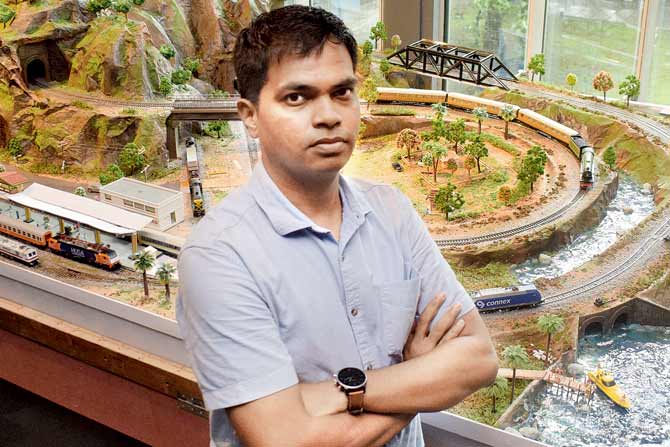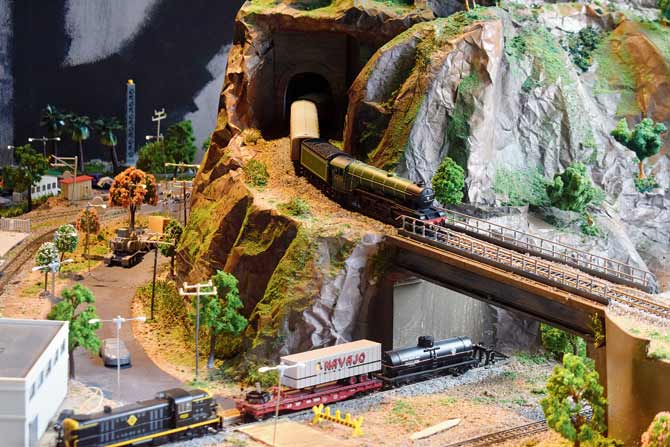JJ school artist Pratik Aroskar works on eco-friendly illumination of Mumbaiu00e2u0080u0099s most-visited museum, and yet he is known for customised jugaad solutions for conservation of objects of historical value

.
 In an exhibition named Small Matters, currently on at the Chhatrapati Shivaji Maharaj Vastu Sangrahalaya (CSMVS), the live diorama of five miniature trains has an interesting association. The working scale locomotive models, running on digital command, come from the personal collection of Pratik Aroskar, a 33-year-old visual artist who happens to be an exhibition associate of the Grade 1 Heritage Museum Building, which houses 60,000 multicultural artifacts from Asia and Europe. Aroskar has created a hilly tunneled landscape to generate popular interest in the railroad network that can engage children and adult viewers alike. The display is geared towards finding intricacies of minute scaled-down versions, which otherwise go unnoticed in gigantic real-life forms. In fact, the entire exhibition, curated by Joyoti Roy, of 377 odd objects—Golu dolls to plant figurines to kitchen-toy sets, along with depictions of community festivities—opens the expansive world of miniaturisation in Indian society, particularly in performing arts, worship and child play.This is the 28th exhibition Aroskar has illuminated since he joined CSMVS 10 years ago. He also teaches a module on light management in the post-graduate museology course being offered by the museum for the last three years.
In an exhibition named Small Matters, currently on at the Chhatrapati Shivaji Maharaj Vastu Sangrahalaya (CSMVS), the live diorama of five miniature trains has an interesting association. The working scale locomotive models, running on digital command, come from the personal collection of Pratik Aroskar, a 33-year-old visual artist who happens to be an exhibition associate of the Grade 1 Heritage Museum Building, which houses 60,000 multicultural artifacts from Asia and Europe. Aroskar has created a hilly tunneled landscape to generate popular interest in the railroad network that can engage children and adult viewers alike. The display is geared towards finding intricacies of minute scaled-down versions, which otherwise go unnoticed in gigantic real-life forms. In fact, the entire exhibition, curated by Joyoti Roy, of 377 odd objects—Golu dolls to plant figurines to kitchen-toy sets, along with depictions of community festivities—opens the expansive world of miniaturisation in Indian society, particularly in performing arts, worship and child play.This is the 28th exhibition Aroskar has illuminated since he joined CSMVS 10 years ago. He also teaches a module on light management in the post-graduate museology course being offered by the museum for the last three years.
Aroskar did not set out to be the light in-charge. After securing his degree in Fine Arts from JJ School of Arts (2008), he did sundry jobs in the film industry, one unlike the other. He worked as a tattoo artist in the Ketan Mehta-directed Rang Rasiya as well as the TV reality show Entertainment Ke Liye Kuch Bhi Karega; he dabbled in 3D animation for a cartoon network channel; then illustrated book covers, designed outdoor hoardings/banners and handled exhibitions on a freelance basis. He didn't know that each sundry assignment would be a building block in his profile as a conservation assistant at CSMVS. The initial years at the museum included a variety of responsibilities that encouraged wider interests—starting from rudimentary cleaning of antiques to caption design to making of graphic panels to fashioning out exhibition invites.
ADVERTISEMENT

Pratik Aroskar
"I could get an enviably rounded view of working at a premier cultural institution that Mumbai prides on. In fact, it was a dream career that I had not consciously worked for," says Aroskar, who narrates exciting anecdotes of his involuntary induction in discrete projects—he was in the backstage team for the hosting of the conference of Commonwealth Association of Museums; he provided technical help in Mummy: The Inside Story exhibition; he was witness to the making of the commemorative exhibition on actor Shammi Kapoor.
Aroskar worked with experts on enlivening the museum's interactive corners which encourage visitors to participate in fun activities. For example, the Textile gallery urges the visitor to play a Match the Patch game in which a traditional weave is to be synchronized with the state of its origin. He has particularly fond memories of working with curator (also renowned painter) Dilip Ranade on an exhibition on Treasures of Ancient China. "He showed me the smallest of components that go into visualising an enormous (30x8 feet) introductory panel reflecting Chinese riches and motifs. I benefited from his painstaking effort in object labelling and documentation practices," recalls Aroskar.
The making of the Himalayan gallery, which is one of the 23 permanent galleries of CSMVS, also provided an opportunity to Aroskar to travel to Dharamshala. As part of a recce of the region with then director Manisha Nene, Aroskar helped in capturing Buddhist places of worship and art. At one juncture in Mcleodganj, the CSMVS team recorded the traditional Tibetan yak butter sculptures. The video is till date a much-appreciated piece of documentation for Mumbaikars who haven't been to Buddhist monasteries to witness Dri butter offerings.
As the exhibition associate learning on the job, Aroskar grasped the integrality of light design in the enhancement of a visitor-friendly museum experience; he also discovered that 'illumination' was a collaborative process which involved periodic interaction with the staff manning varied spaces. For instance, the Arms and Armour gallery and the Natural History section need different treatment, as against the Numismatics corner or the TV kiosks for visitors; the taxidermised mammal and fish-reptile sections require particularly 'kinder' lighting as over-lit derma is subject to decay over a period of time. The open corridors where daylight is abundant require distinct lighting, especially in a sunny tropical country where harsh sunrays can damage handwritten manuscripts and other delicate artefacts. In fact, Aroskar's visit to London's iconic museums has taught him much about climate-appropriate light design, which also led to CSMVS' switchover from traditional incandescent lamps or tube lights to LED lighting.
Aroskar makes a special mention of CSMVS Director General Dr Sabyasachi Mukherjee's insights on mood-appropriate illumination. Two years ago, he specified super-small spotlights for the first floor Circular Gallery of Visual Art which houses rare Bombay School paintings, so that it could bring alive diverse elements in the range of paintings from the 1880s to 1950s. Aroskar scouted for vendors in Mumbai's hardware haunts, and later worked with the museum electrician to create a suspended track on which the LED spots hung. He called that a team jugaad, other examples of which abound. The low-beam angle lights for the Himalayan gallery, which he worked on, were a result of 'workshopping' his way through the market products he could not readily source; similarly the support stands he has devised for the Sculpture gallery help in 'highlighting' items for popular reception.

Jugaad comes naturally to Aroskar, thanks to his childhood at Sai Krupa Niwas chawl in Jogeshwari where customised life solutions were circulated freely. "Life in the lower-middle class neighbourhood involved daily Mumbai struggles, which added spice to everyday living. Children were encouraged in crafts, be it the Ganesh pandal or the Diwali party, as a way of life." Aroskar grew in the tutelage of local carpenter Mangesh Sutar whose small-time factory space opened the world of wooden artistry. Close to the chawl were Ganpati idol-making workshops which further shaped his sensibilities. His father was in BMC's road maintenance department, mother was a homemaker, and no one else in the family with boast-worthy artistic talents. But the chawl had a vibrant vibe which encouraged music and dance. Similarly, the school (Bal Vikas Vidya Mandir) inspired participation in sports like kho kho, kabaddi and long jumps. The school's art teacher pushed him into appearing for government's elementary art exams, which later became Aroskar's foundation for entering the JJ School of Art. "Art flowered in the form of a confluence of forces, a convergence that I was unknowingly part of."
When Aroskar speaks to museology aspirants in CSMVS' course, he stresses the importance of the convergence that each Mumbaikar can locate in his or her life. In fact, he feels that a wider interest in preservation is at the root of any museum experience because if we want to pass on something precious—a gem, a loom or a copper plate tamrapat—we have to take care of it. "We have to 'highlight' its presence, and also increase its longevity. Our national identity is at stake otherwise," he maintains. Enlightening that is.
Sumedha Raikar-Mhatre is a culture columnist in search of the sub-text. You can reach her at sumedha.raikar@gmail.com
Catch up on all the latest Mumbai news, crime news, current affairs, and also a complete guide on Mumbai from food to things to do and events across the city here. Also download the new mid-day Android and iOS apps to get latest updates
 Subscribe today by clicking the link and stay updated with the latest news!" Click here!
Subscribe today by clicking the link and stay updated with the latest news!" Click here!







